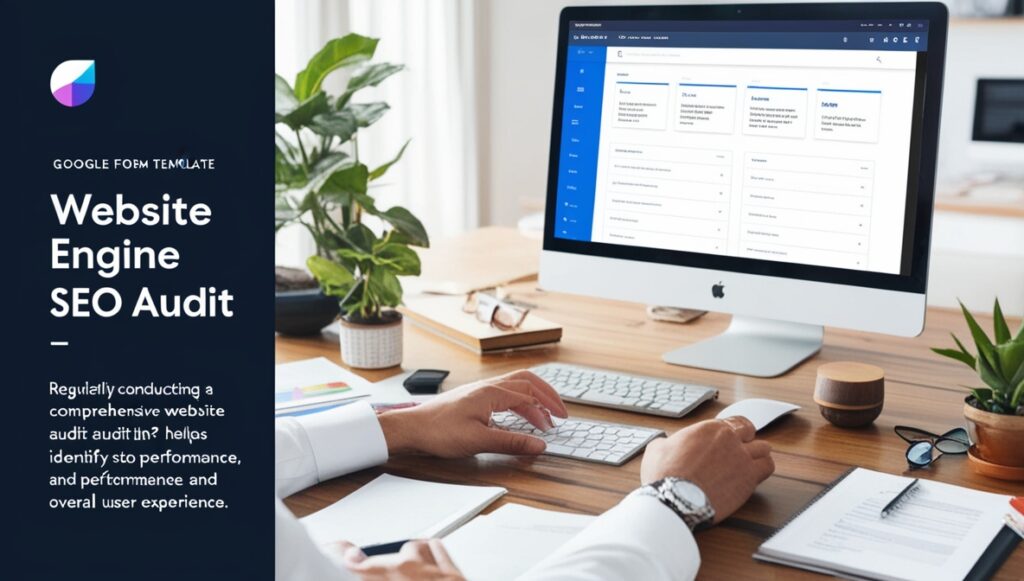
In the fast-paced digital landscape, an effective online presence is essential for businesses to thrive. One of the most critical components of a robust digital strategy is search engine optimization (SEO). Regularly conducting a comprehensive SEO audit helps identify areas for improvement, optimize website performance, and enhance overall user experience. In this article, we will delve into the significance of conducting a website SEO audit, as well as provide a Google Form template to streamline your auditing process.
What is an SEO Audit?

An SEO audit is a comprehensive examination of your website’s performance in terms of search engine optimization. Conducted either manually or through automated tools, the audit assesses various elements that affect your site’s visibility on search engines. The primary goal is to identify weaknesses and opportunities for improvement, ensuring that your website aligns with the best practices set by search engines like Google.
Importance of an SEO Audit

- Identifying Technical Issues: A well-executed SEO audit uncovers technical problems that may hinder your site’s performance, such as broken links, slow loading times, and mobile responsiveness.
- Enhancing User Experience: SEO audits assess user engagement metrics like bounce rates and session duration, crucial for refining user experience and keeping visitors on your site longer.
- Keeping Up with Algorithm Changes: Search engines frequently update their algorithms. Regular audits ensure your website adheres to the latest guidelines, preventing potential penalties.
- Improving Search Rankings: By identifying and resolving issues, SEO audits can boost your website’s visibility in search engine results pages (SERPs), driving more organic traffic.
Essential Elements of a Website SEO Audit
To conduct a thorough SEO audit, it’s important to cover several key areas. Below is a detailed breakdown of the elements to include:
1. Technical SEO
- Site Speed: Use tools like Google PageSpeed Insights to measure load times and identify areas for improvement.
- Mobile-Friendliness: Check if your website is responsive and provides a good experience on mobile devices using Google’s Mobile-Friendly Test.
- Crawlability and Indexability: Ensure that search engines can easily crawl your site and that important pages are indexed. Utilize robots.txt and XML sitemaps to guide search engines.
2. On-Page SEO
- Title Tags and Meta Descriptions: Review all title tags and meta descriptions for character limits and keyword inclusion.
- Header Tags: Ensure proper use of header tags (H1, H2, H3) to structure content effectively.
- Content Quality: Assess the quality, relevance, and uniqueness of the content across your site. Check for missing or duplicate content.
3. Off-Page SEO
- Backlink Profile: Evaluate the quantity and quality of incoming links. Tools like Ahrefs or Moz can help analyze backlinks and identify toxic links that may harm your ranking.
- Social Signals: Consider the engagement and shares your content receives on social media platforms as this can indirectly affect your SEO.
4. User Experience
- Bounce Rate and Time on Site: Monitor user engagement analytics to understand how visitors interact with your site.
- Navigation and Structure: Review the site layout, ensuring that it is logical and intuitive for users.
Creating a Website SEO Audit Google Form Template
To streamline your auditing process, a Google Form can be an effective tool for collecting audit data. Below is a template outline you can use for your SEO audit, structured in a way that covers all necessary elements:
Google Form Template Structure
Section 1: General Information
- Website URL: [Input Field]
- Date of Audit: [Date Picker]
- Auditor Name: [Input Field]
Section 2: Technical SEO
- Check Site Speed:
- [Multiple Choice] “Is the site loading within 3 seconds?”
- [Checkboxes] “Issues found (check all that apply):”
- Slow loading
- Not mobile-friendly
- Crawl issues
- Crawlability & Indexability:
- [Multiple Choice] “Is the site easily crawlable?”
- Yes
- No
- [Paragraph] “Comments on crawlability:”
- [Multiple Choice] “Is the site easily crawlable?”
Section 3: On-Page SEO
- Title Tags:
- [Paragraph] “List potential improvements for title tags:”
- Meta Descriptions:
- [Paragraph] “Provide suggestions for enhancing meta descriptions:”
Section 4: Content Review
- Content Quality:
- [Multiple Choice] “Is the website’s content unique and relevant?”
- Yes
- No
- [Multiple Choice] “Is the website’s content unique and relevant?”
Section 5: Off-Page SEO
- Backlink Profile:
- [Paragraph] “Summary of backlink analysis results:”
Section 6: User Experience
- User Engagement Metrics:
- [Multiple Choice] “Do users stay on the site longer than 2 minutes?”
- Yes
- No
- [Multiple Choice] “Do users stay on the site longer than 2 minutes?”
Additional Comments
- [Paragraph] “Any additional observations or recommendations?”
By using this template, you will streamline the SEO auditing process and ensure consistency in data collection.
Conclusion

Conducting a website SEO audit is a crucial step in optimizing your online presence, enhancing user experience, and improving search engine rankings. An effective audit covers technical SEO, on-page and off-page SEO, and user experience aspects. By utilizing the provided Google Form template, you can streamline your auditing process, making it easier to identify weaknesses and areas for growth.
If you’re looking to enhance your website’s performance, considering professional SEO services like those offered by Dust Digital Marketing Ltd. can propel your business to new heights. Our team of experts is proficient in conducting detailed SEO audits and implementing strategies tailored to your unique needs. Visit our website at Dust Digital Marketing to learn more.

